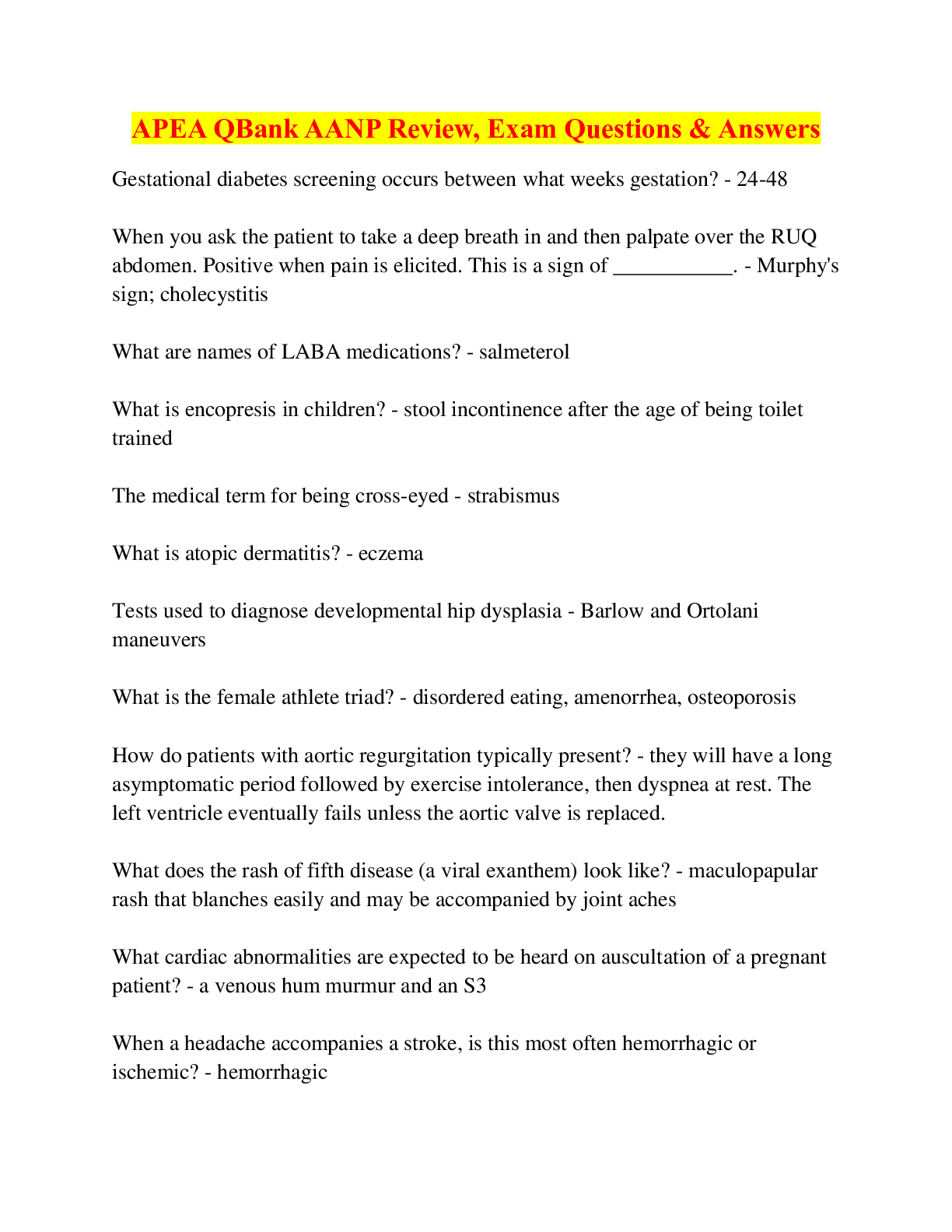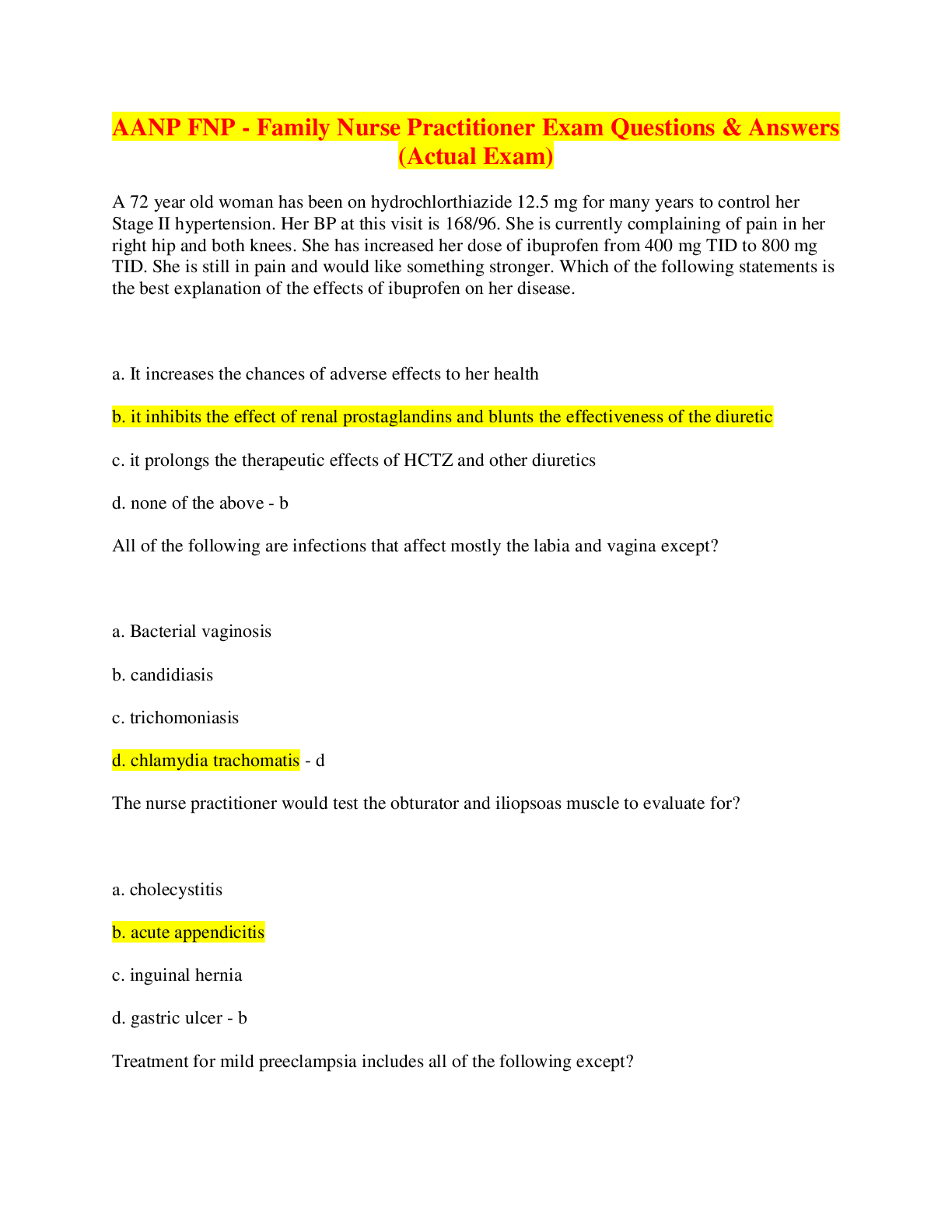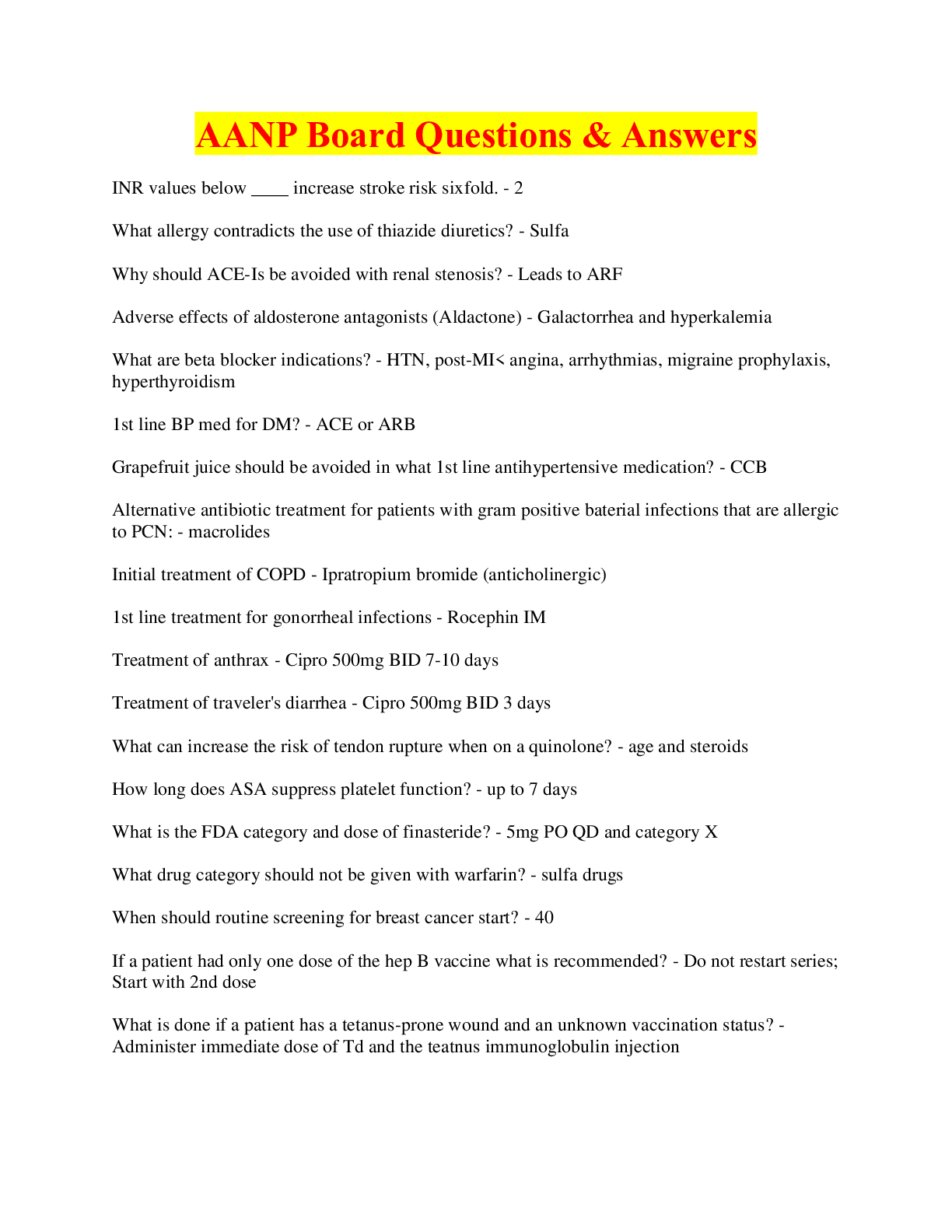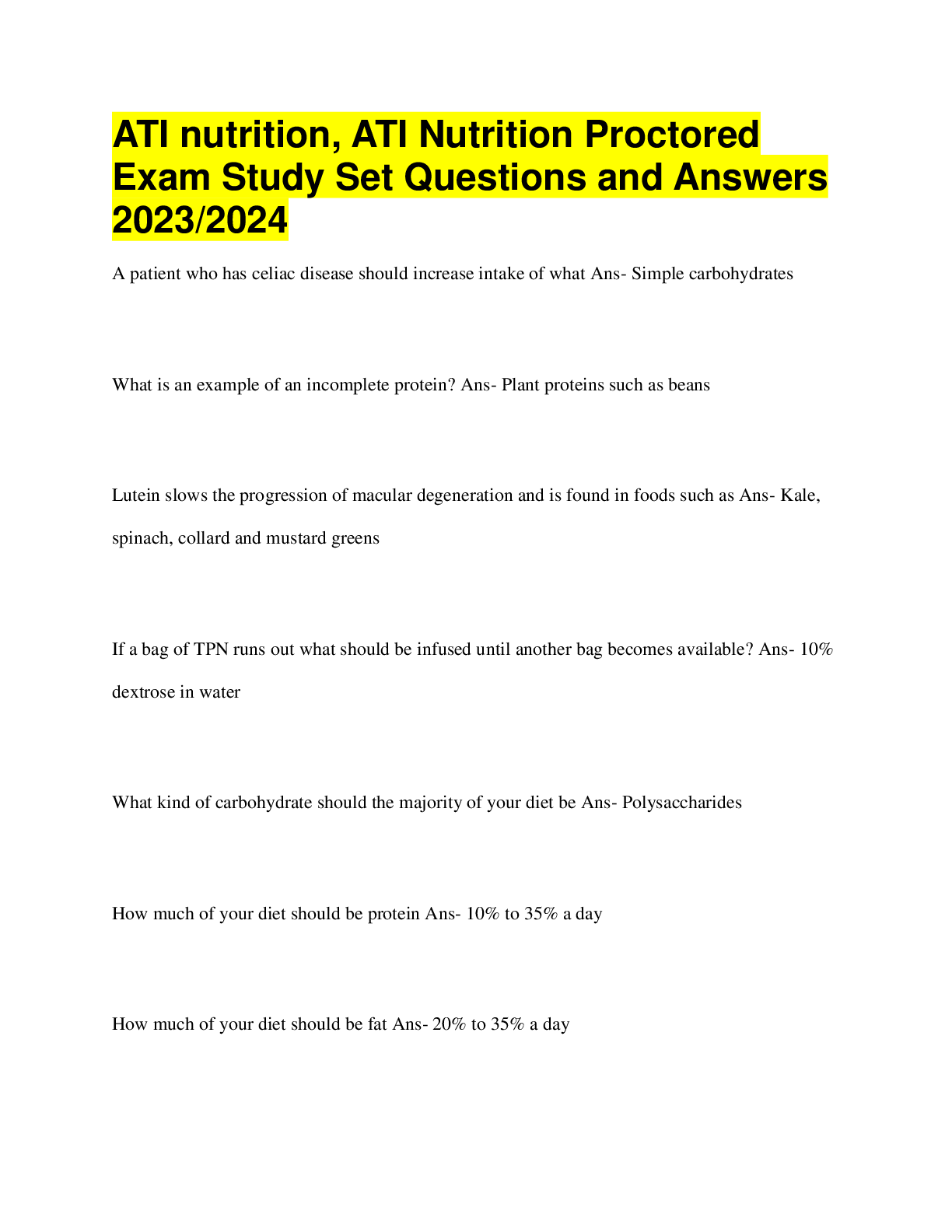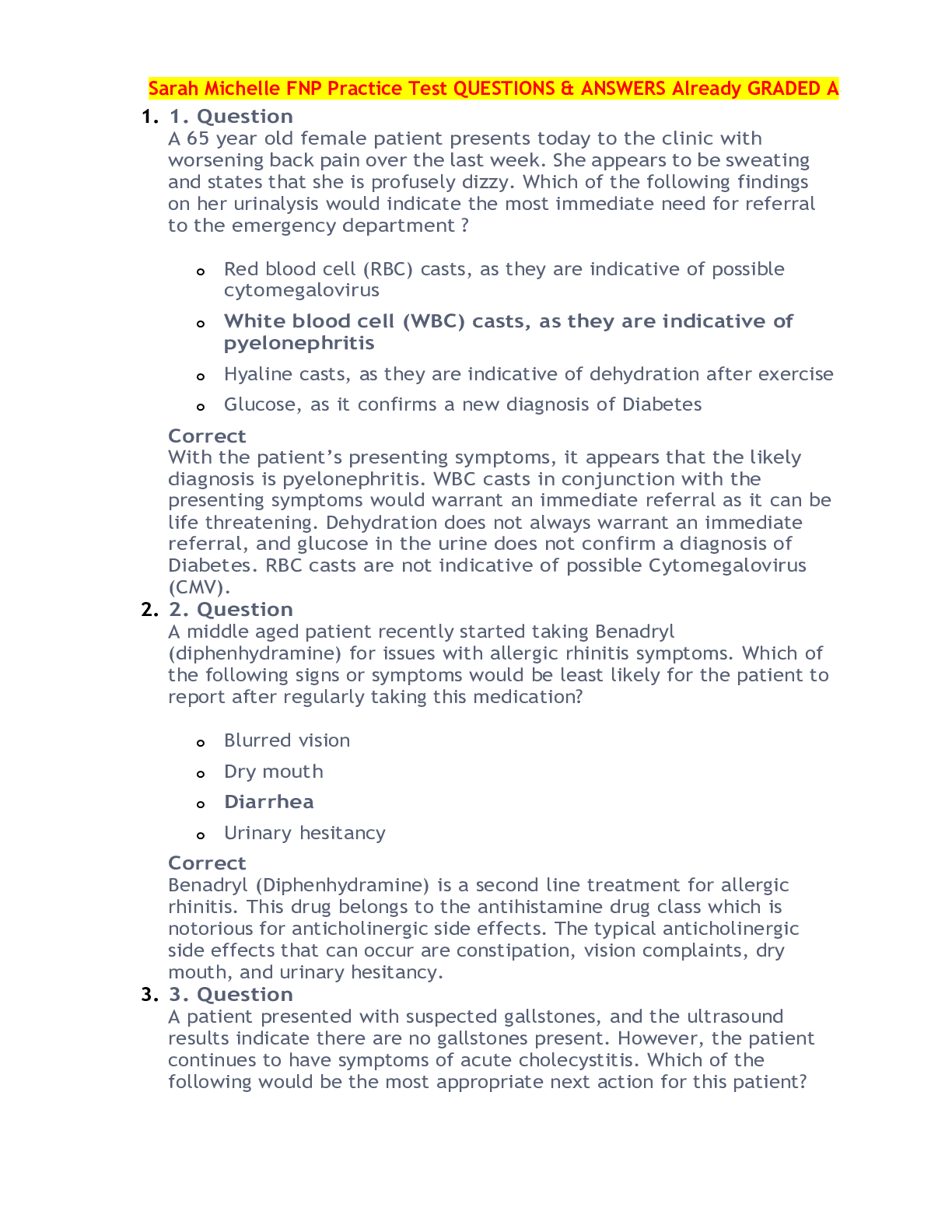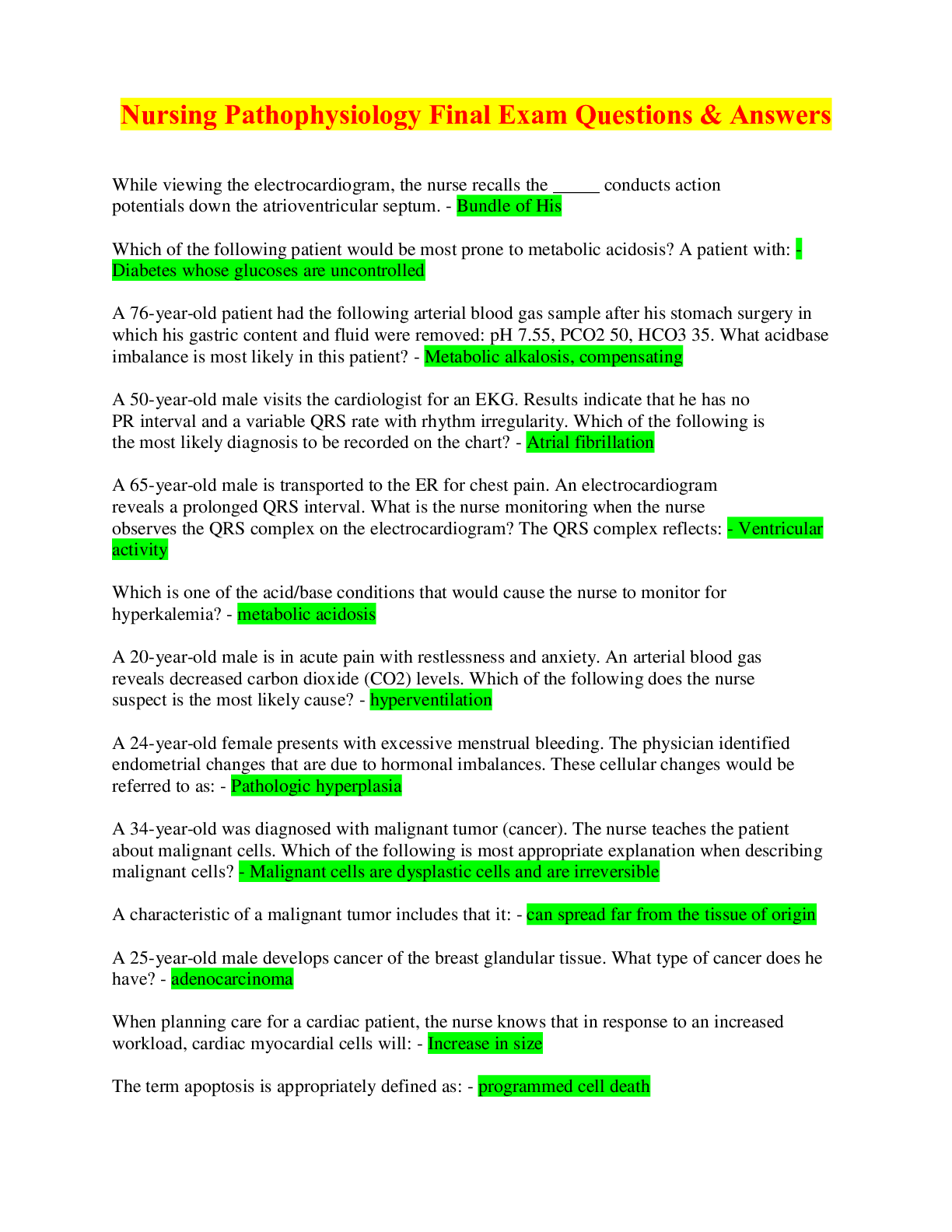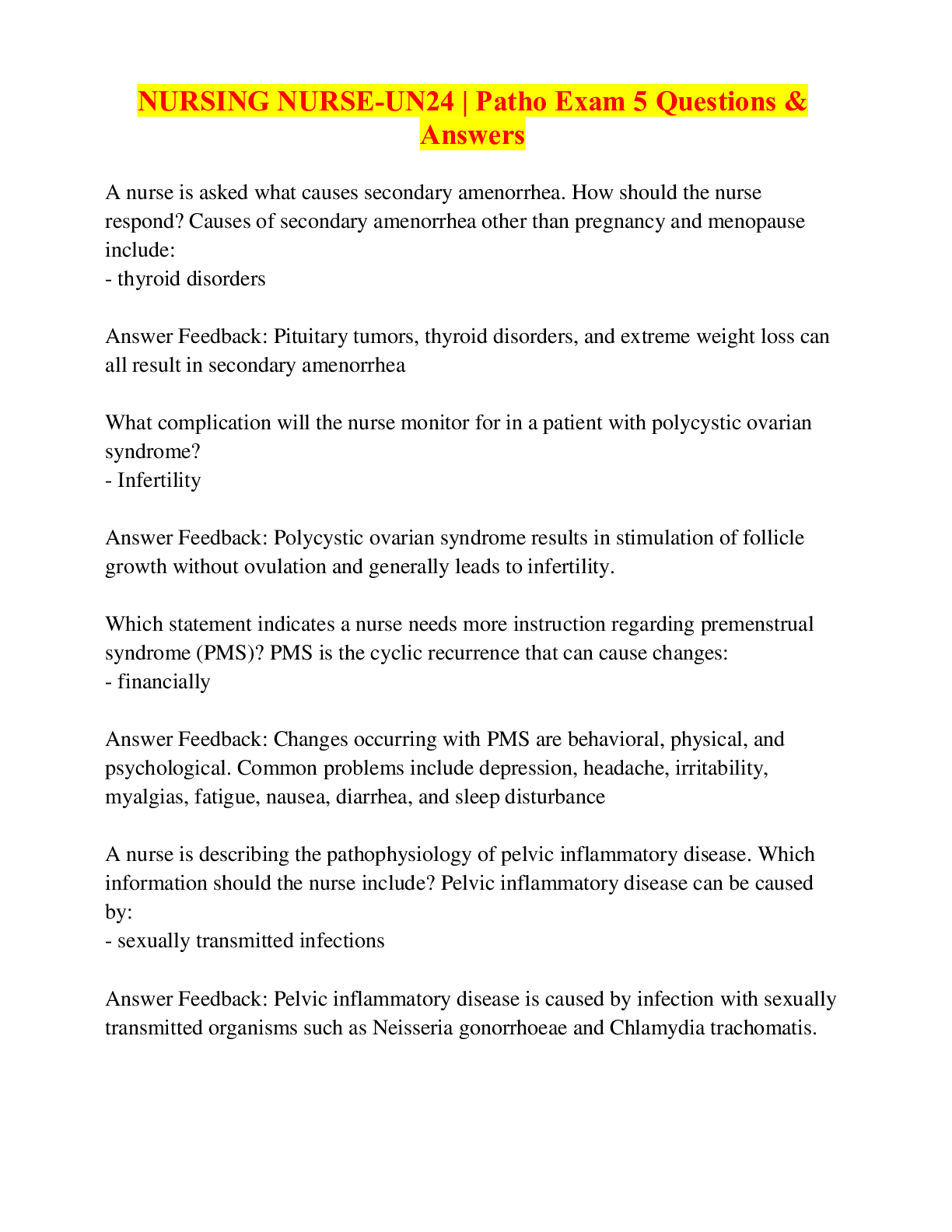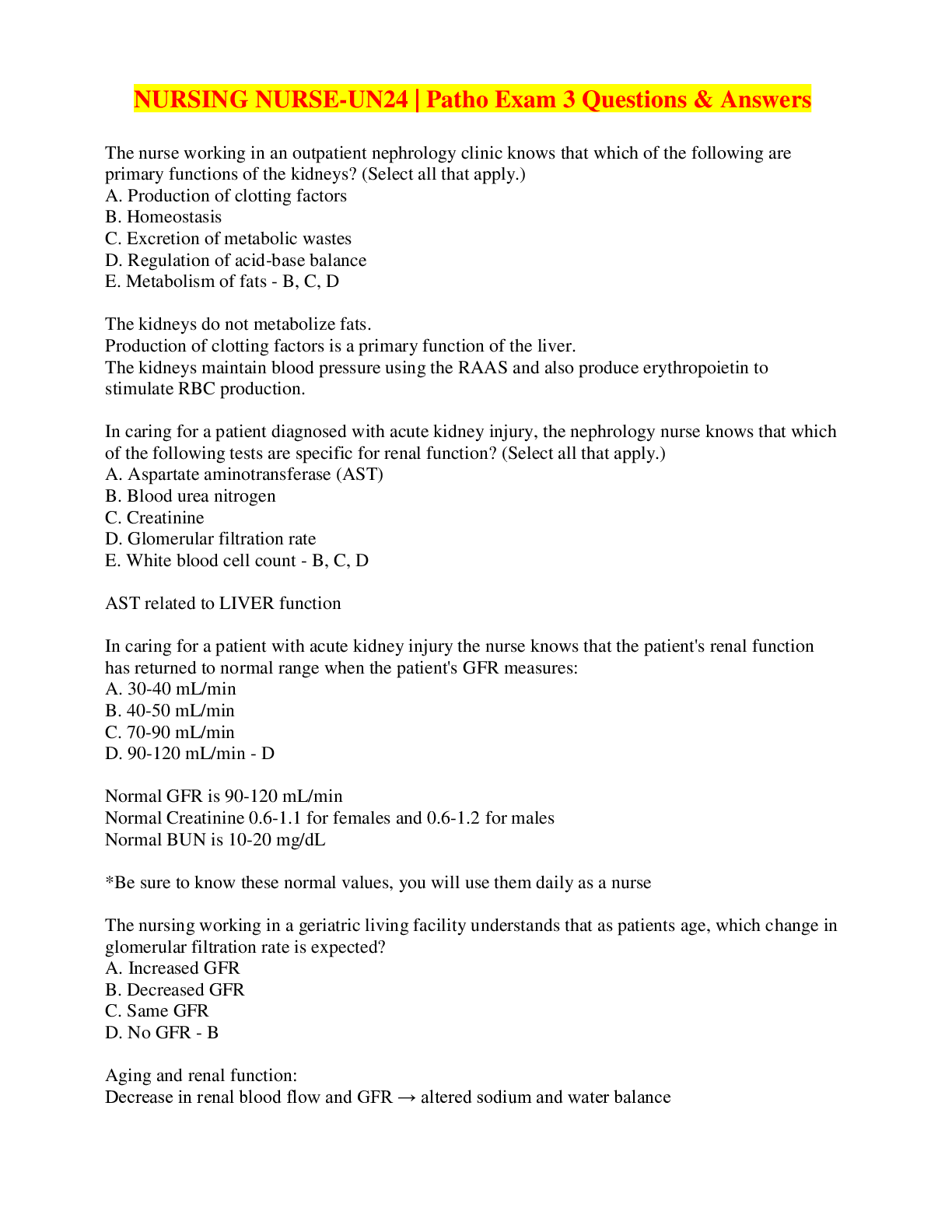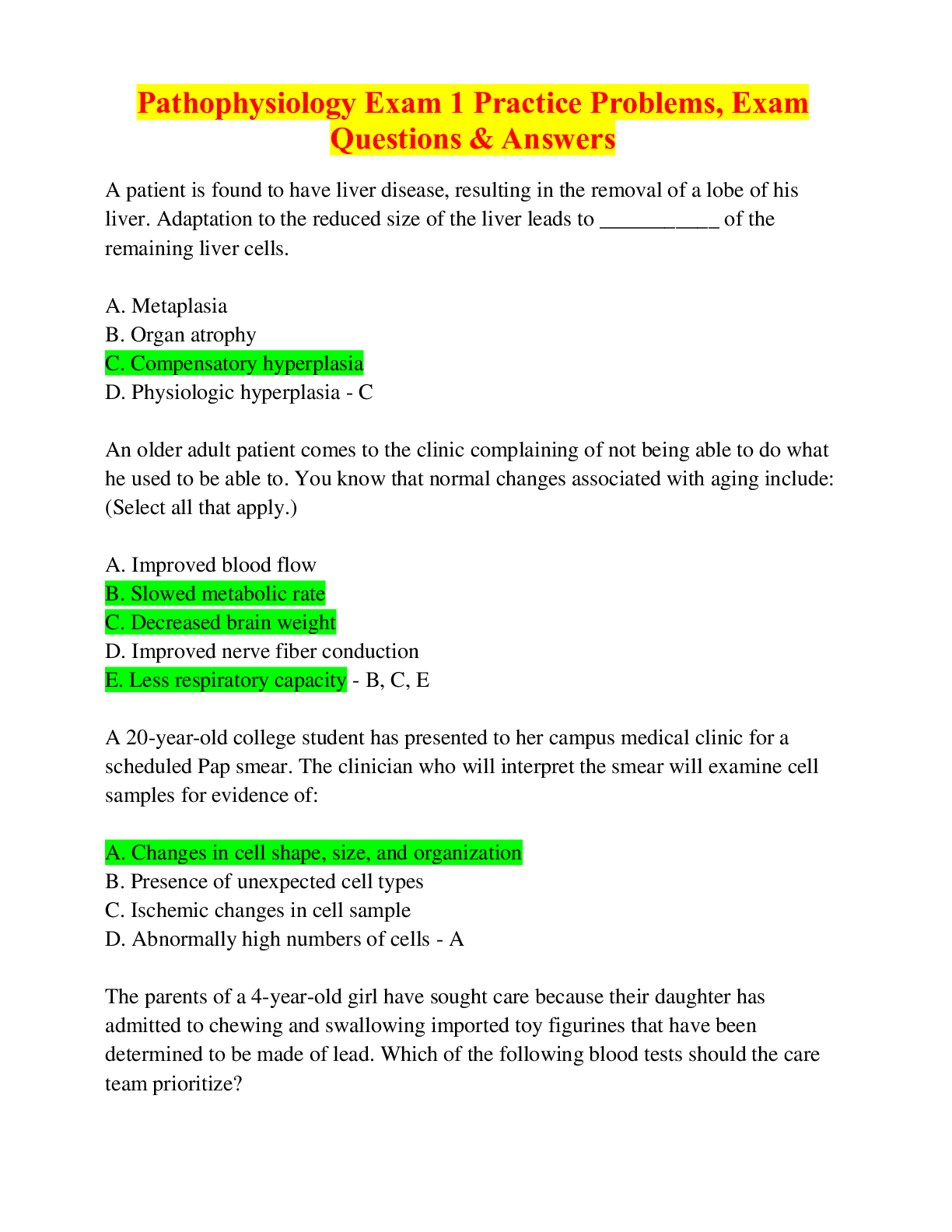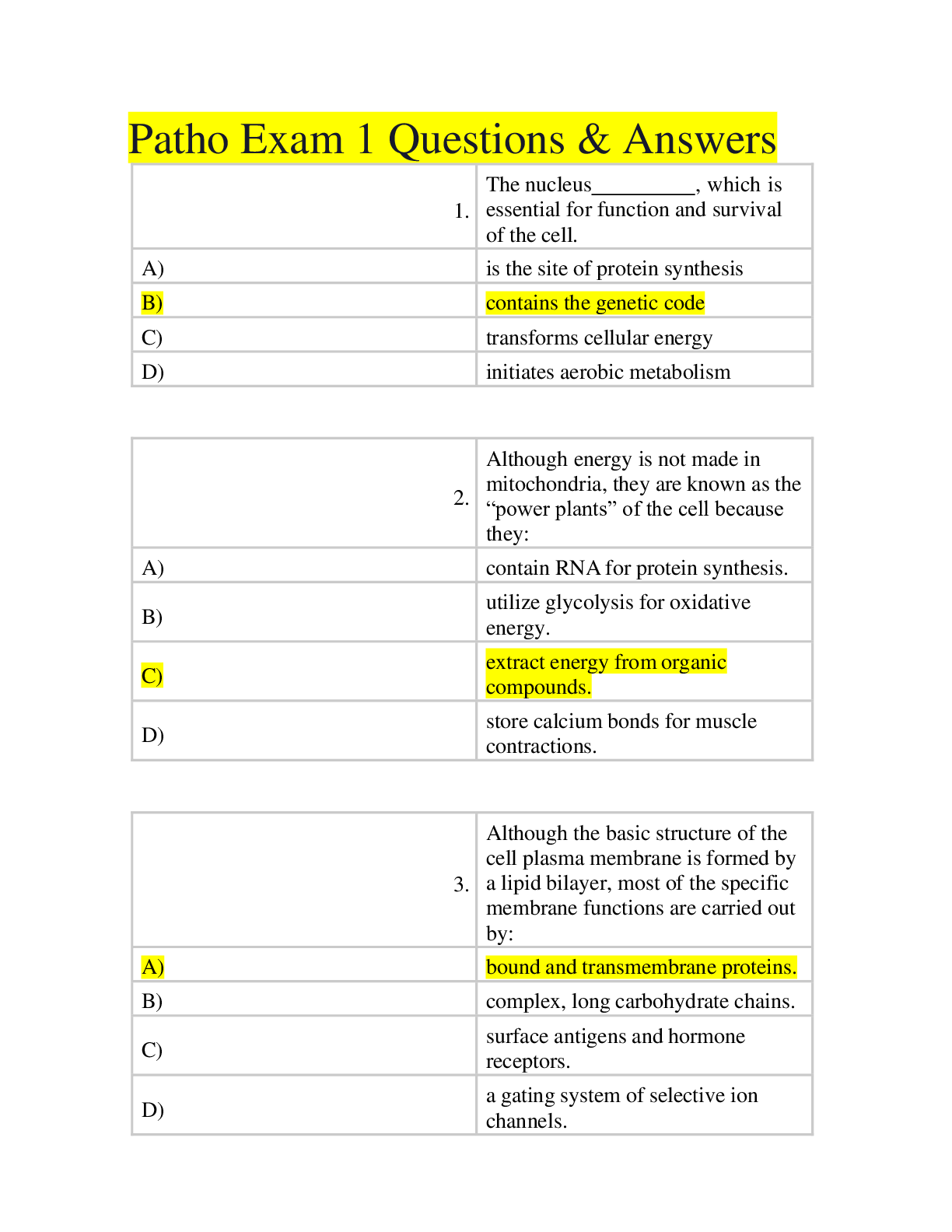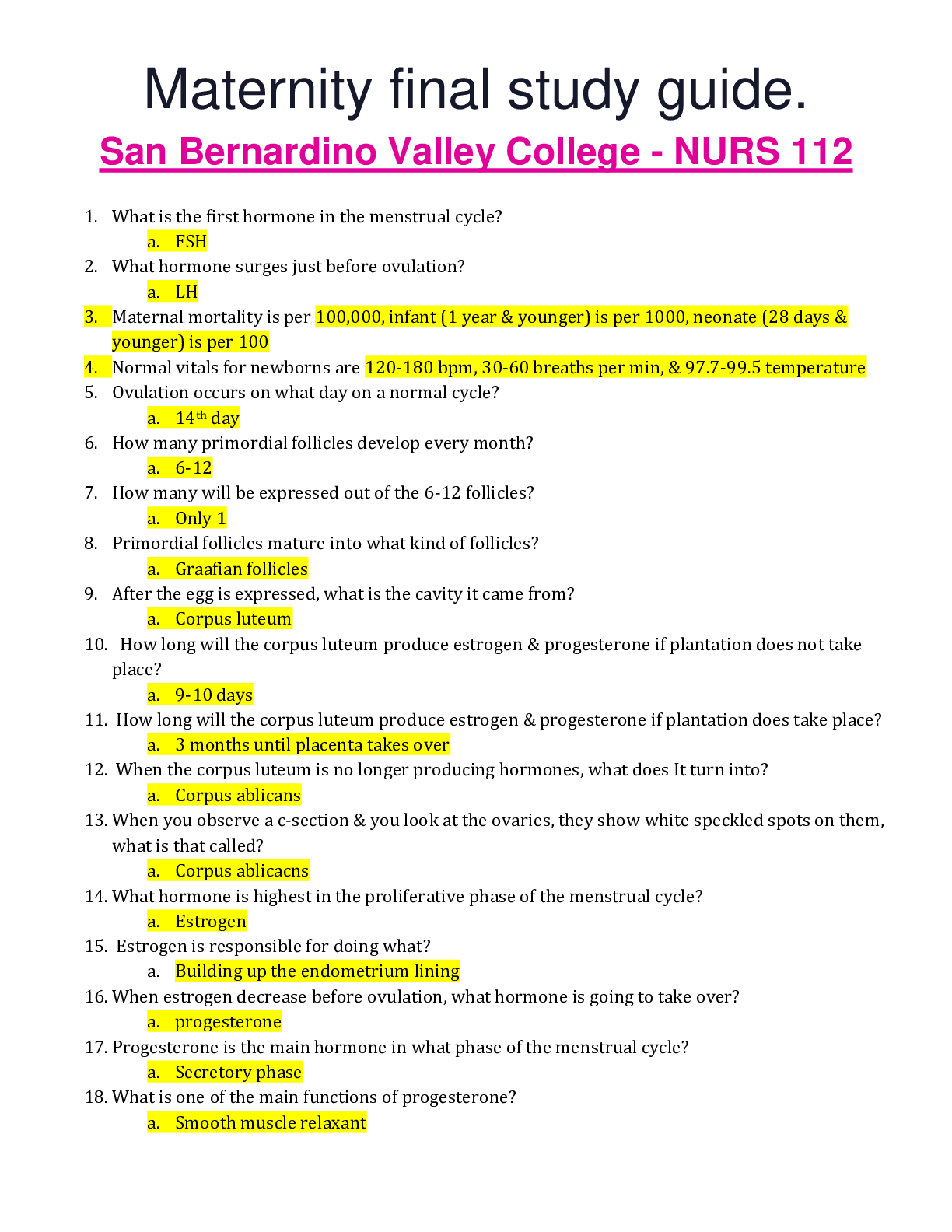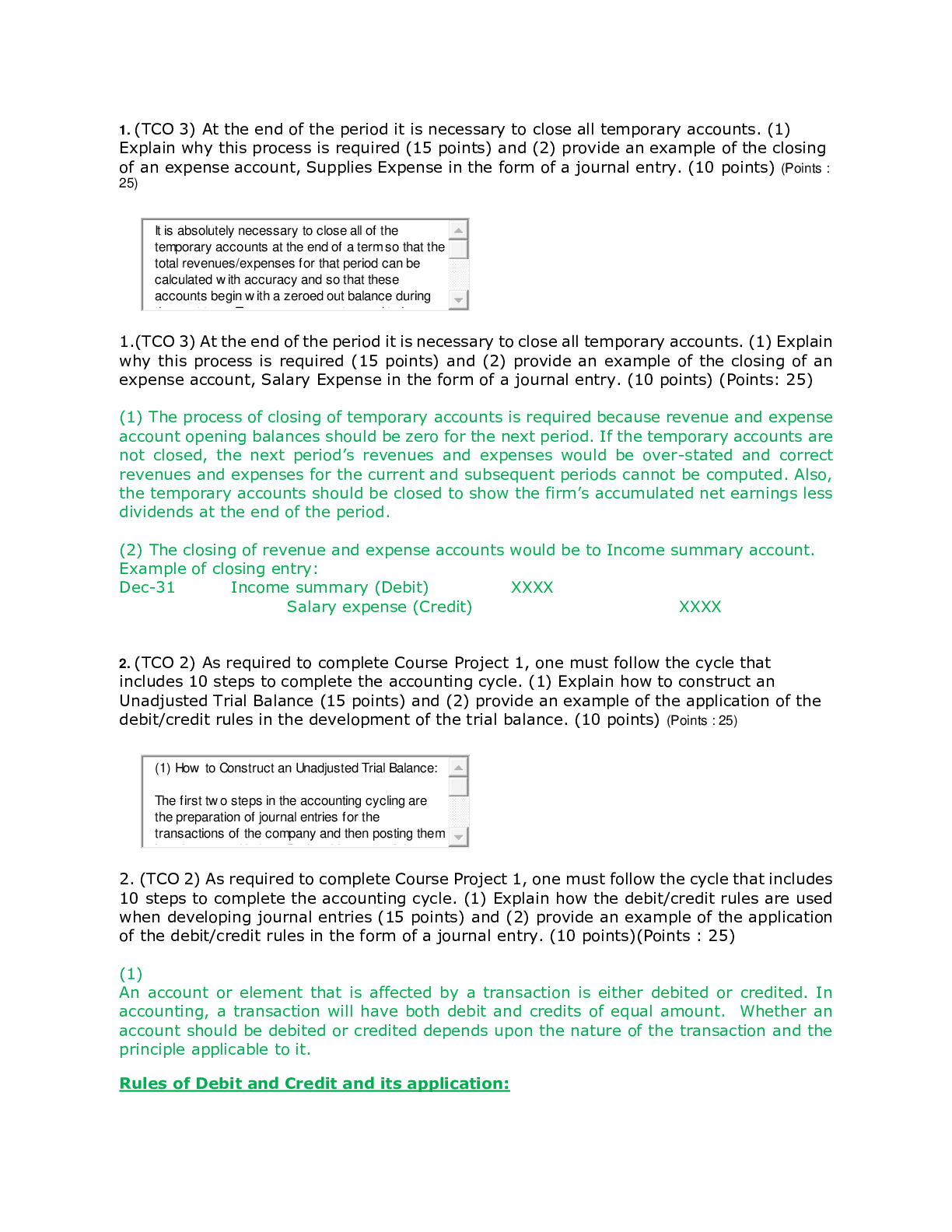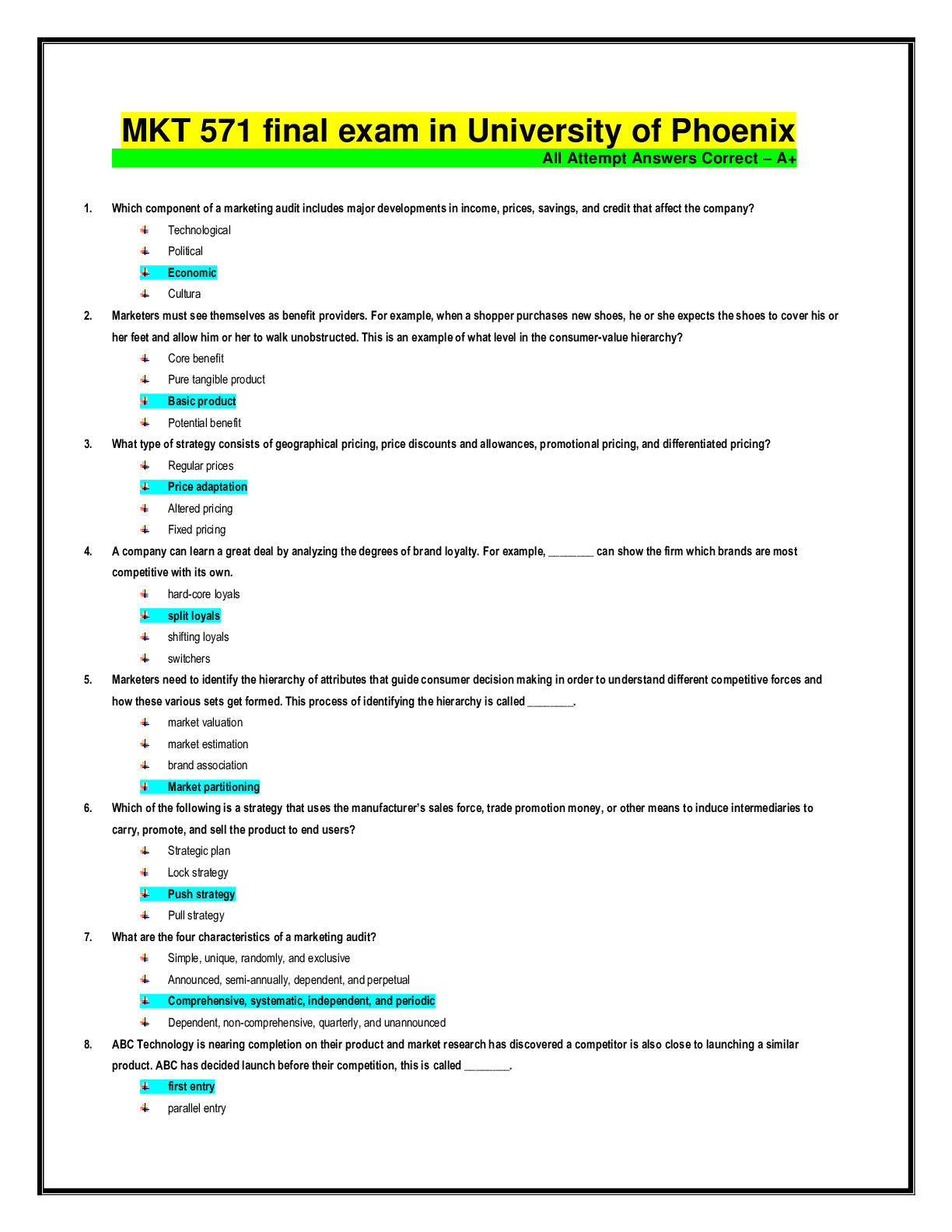NUR 210 FINAL LATEST EXAM QUESTIONS & ANSWERS ALL GRADED A COMPILATION.
Document Content and Description Below
NUR 210 FINAL LATEST EXAM QUESTIONS & ANSWERS ALL GRADED A COMPILATION.-1. The client who has been hospitalized with pancreatitis does not drink alcohol because of the religious convictions. The clien... t becomes upset when the healthcare provider persist in asking about alcohol intake what should the nurse tell the client about the reason for these questions? • There is a strong link between alcohol use and acute pancreatitis. 2. A client with acute pancreatitis has a blood pressure of 88/40 heart rate of 128 bpm respirations of 28 breaths per minute and gray tuners sign. What prescription should the nurse implement first? • Place an IV line 3. The nurse should monitor the client with a cute pancreatitis for which complication? • Pneumonia 4. When the nurse is providing care for a client hospitalized with a cute pancreatitis who has severe of Domino pain which nursing intervention would be most appropriate for this client select all that apply. • Place the client in a sidelying position, • administer morphine sulfate for pain as needed, • monitor the clients respiratory status, • obtain daily weights. 5. The nurse notes of a client with a cute pancreatitis occasionally experience is muscle twitching and jerking. How should the nurse interpret the significance of the symptoms? • The client may be developing hypocalcemia. 6. A client is receiving propantheline bromide in the management of acute pancreatitis. Which finding would indicate that the nurse should discuss withholding the medication with the health care provider? • Absent bowel sounds 7. Which dietary instruction would be appropriate for the nurse to give a client who is recovering from acute pancreatitis? • Avoid crash dieting 8. Pancreatic enzyme replacements are prescribed for the client with chronic pancreatitis. When should the nurse instruct the client to take them to obtain the most therapeutic effect? • With each meal and snack 9. The client has chronic pancreatitis. What should the nurse teach the client to do to monitor the effectiveness of pancreatic enzyme replacement? • Observe stools for steatorrhea 10. The nurse is assessing a client with chronic hepatitis b who is receiving Iamivudine. What information about the client is most important to communicate to the health care provider? • A 3 kg weight gain over 2 days 11. The nurse is caring for a client with a history of alcoholism. Which findings would indicate that the client has possibly developed chronic pancreatitis? Select all that apply: • fatty stools, • constipation and • flatulence Hepatitis: 1. The nurse is assessing a client with hepatitis A and notices that the AST and a LT lab values have increased. Which statement by the client indicates a need for further instruction by the nurse? • I take acetaminophen for arthritis pain 2. A client plans to travel to a country or hepatitis B is common. What should the nurse advised the client about the most effective way to prevent the disease? • Complete the vaccination series 3. Which finding is normal for a client during the icteric phase of hepatitis A? • Yellowed sclera 4. The nurse is teaching an adult recreational drug user about measures to avoid acquiring hepatitis A. What information should the nurse include in the instruction? Select all that apply; • observing proper handwashing technique, • following safe syringe disposal procedures, • obtaining a vaccination, • using caution with eating fresh fruits and vegetables. 5. A client with chronic hepatitis C is experiencing nausea anorexia and fatigue. During the health history the client states that he is homosexual, drinks 1 to 2 glasses of wine with dinner, and is taking St. John’s wort for a bit of depression and it takes acetaminophen for frequent headaches. What should the nurse do? Select all that apply; • instruct the client to ask the healthcare provider about taking any other medications as they may interact with medications the client is currently taking, • advise the client of the need for additional testing for HIV, and • encourage the client to obtain sufficient rest. 6. A client who is recovering from hepatitis A has fatigue and malaise. The client asked the nurse when will my strength return? Which response by the nurse is most appropriate? • It is normal for you to feel fatigued. The fatigue should go away in the next 2 to 4 months. 7. The nurse is caring for a client recently diagnosed with hepatitis C. In reviewing the clients history what information will be most helpful as a nurse develop the teaching plan? • Has a known history of sexually transmitted disease 8. A client recently diagnosed with hepatitis C states now that you know what’s wrong with me you can just get me those new drugs and take care of it right? What should the nurse tell the client? • There are new antiviral drugs available that may make treatment more effective and help you tolerate it better 9. The nurse is developing a teaching plan for the client with viral hepatitis. What information should the nurse include in the plan? • Obtain adequate bedrest 10. When planning care for a client with hepatitis A the nurse to review laboratory reports for which of the following laboratory values? • Prolonged PT time 11. The nurse is developing a teaching plan for a client with hepatitis A. What should the nurse tell the client to do? • Increase carbohydrates and protein in the diet 12. The nurse involves a teaching plan for the client about how to prevent the transmission of hepatitis A. Which discharge instruction is appropriate for the client? • Ask family members to wash their hands frequently 13. The client with hepatitis A is experiencing fatigue, weakness, and a general feeling of malaise. The client tires rapidly during morning care. What is the most appropriate for this client? • Gradually increase activity tolerance 14. Interferon alfa-2b has been prescribed to treat a client with chronic hepatitis B. The nurse should assess the client for which common adverse effect? • Flu like symptoms 15. The nurse is preparing a community education program about preventing hepatitis B infection. Which information should be incorporated into the teaching plan? • The use of a condom is advised for sexual intercourse 16. The nurse is establishing goals for the client with hepatitis A. which goal is appropriate the client will; • verbalize the importance of reporting bleeding gums or bloody stools Cirrhosis: 1. The nurse should evaluate the results of which laboratory test while caring for a client who has cirrhosis of the liver select all that apply: • PT time • serum albumin 2. Which assessment me by the nurse could indicate the development of portal hypertension and a client with cirrhosis select all that apply: • hemorrhoids, • splenomegaly, • ascites 3. The nurse is caring for a client who has ascites and a healthcare provider prescribes Sprinolactone. When the client ask why this drug is being used what is the best response by the nurse? • This medication is a diuretic but does not make the kidneys excrete potassium. 4. When caring for a client who has cirrhosis the nurse knows is flapping tremors of the wrist and fingers. How does the nurse chart this finding? • Asterixis noted. 5. A client had a liver biopsy 1 hour ago. What should the nurse do first? • Auscultate lung sounds 6. A client with cirrhosis is receiving lactulose. The notes notes the client is more confused and has asterixis. What should the nurse do next? • Assess for GI bleeding. 7. The nurse is assessing a client with cirrhosis who has developed hepatic encephalopathy. The nurse should notify the health care provider of a decrease in which serum lab value that is a potential precipitating factor for hepatic encephalopathy? • Potassium 8. A client has advanced cirrhosis of the liver. The clients spouse asks the nurse why his abdomen is swollen, making it very difficult for him to fasten his pants. How should the nurse respond to provide the most accurate explanation of the disease process? • Blood is not able to flow readily through the liver now, and the liver can not make protein to keep fluid inside the blood vessels. 9. A nurse is developing a care plan for a client with hepatic encephalopathy. Which are goals for the care of this client? Select all that apply: • prevent constipation, • administer lactulose to reduce blood ammonia levels, • monitor coordination while walking, • check pupil reaction, • provide food and fluids high in carbohydrate 10. The nurse is assessing a client who is in the early stages of cirrhosis of the liver. Which focused assessment is appropriate? • Anorexia 11. A client with cirrhosis begins to develop ascites. Spironolactone is prescribed to treat ascites. The nurse should monitor the client closely for which drug-related adverse effect? • Hyperkalemia 12. What diet should be implemented for a client who is in the early stages of cirrhosis? • High calorie, high carbohydrate 13. A client with jaundice has pruritus and areas of irritation from scratching. What measures can the nurse suggest the client use to prevent skin breakdown? Select all that apply: • add baking soda to the water in a tub bath, • keep nails short and clean, • rub the skin where it itches with knuckles instead of nails. 14. Which health promotion activity should the nurse suggest that the client with cirrhosis add to the daily routine at home? • Abstain from drinking alcohol [Show More]
Last updated: 2 years ago
Preview 1 out of 63 pages
Buy this document to get the full access instantly
Instant Download Access after purchase
Buy NowInstant download
We Accept:

Reviews( 0 )
$15.50
Can't find what you want? Try our AI powered Search
Document information
Connected school, study & course
About the document
Uploaded On
Jun 10, 2021
Number of pages
63
Written in
Additional information
This document has been written for:
Uploaded
Jun 10, 2021
Downloads
0
Views
64

